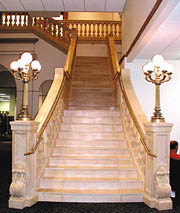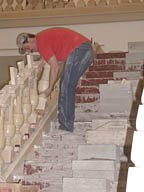

According to Dell Wilson, partner in charge of this project from the architectural firm Uihlein Wilson Architects, work on the historic downtown library had been going on since 1992. The final stage of the three-phase project has just been completed.
"In a broad view, our goal was to upgrade the library and its service to its patrons, but we were also being sensitive to a beautiful historic building," Wilson said. "The library was originally built in 1896, featuring a limestone exterior and marble staircases in the main rotunda. Small additions were made over the years, such as a major contemporary north annex, which was attached to the main structure in the 1950s."
A previous renovation of the old building installed escalators, which were removed in the early 1990s and replaced with flanking wooden stairs. "We then removed the wooden stairs and placed them with a staircase of Jerusalem limestone," Wilson said.
The installation of this grand staircase was the third and final phase of the project. The first phase included constructing a new 15,000-square-foot children's room, and the second phase allowed for the creation of a new art and music room to house the library's extensive collections. "Coupled with the design of the new staircase, the third phase also included the renovation of the business and science room in the contemporary portion of the building," Wilson said. "The stair was part of the formation of a gallery
on the first and second floors, the upper floor of which would be a rare books and archival room."
According to Wilson, the usage of limestone restored the stair to the way it should have been originally. With the help of designer and historian Russell Zimmerman, the overall historic accuracy of the carved balusters and brackets was maintained. Zimmerman consulted on the ornamental design so that the original details could be reconstructed.
The type of stone used in these carvings was also an important factor. "We looked at a large range of stones during the selection process," Wilson said. "The Ramon Gold honed limestone was the right color and texture. The rotunda is quite an ornate and beautifully detailed space, then as you move through the building it becomes more contemporary, calling for less detail and a slightly warmer stone. The second floor gallery is outfitted with wood and a simple plaster. The limestone possessed the right color and feel for that space."
The distributor that was brought in to supply the limestone was Quarra Stone. The company was awarded the public bid to provide the flooring and step treads by the Milwaukee Public Library Foundation. "Later, the foundation decided to raise money to build the ornamental staircases and we were asked to be involved in that process as well," said Jim Durham, president and owner of Quarra Stone. "The original concept of the project was expanded."
Due to the time constraints, Quarra Stone decided that it would not be in their best interest to purchase slabs of limestone for the staircase and also cut the tile for the flooring. And since the two stones needed to be an exact match, the company decided to outsource. "We determined that it would be best if we got all of our material from a single source," Durham said. "So, we bought the tile from Jerusalem Gardens and resold it. It came finished and ready to install. We also got them the drawings for the staircases, and they finished the pieces. Jerusalem Gardens also provided partially finished pieces or raw material for pieces we didn't know the final dimensions of at the time. Some pieces were so complicated that we couldn't know the dimensions in time to send them to Jerusalem and wait, especially since the pieces ramp and twist at the same time, there were differences in the building from one side to the other and the steel wasn't perfect. We accommodated the differences by taking the most difficult pieces that were most subject to field conditions and fabricating them out of raw blocks at Quarra, doing a final fitting at the jobsite."
Having to rework the stone onsite also had an effect on how the installers prepared to put the stone in, according to Bill Dentinger of Bill Dentinger Masonry. "We basically had two to four people working at a time," he said. "We probably could have had more if stone was readily available all at one time."
Roger Spahr, project manager of the installation from Bill Dentinger Masonry agreed that waiting for pieces of stone made the work more difficult. "The end pieces were the biggest challenge," he said. "We had to estimate the weight of the marble we were going to install and preload the steps with concrete blocks to predict the deflection. Then we removed the concrete blocks as we added the marble so it was even."
The whole installation process was completed by hand, the largest pieces being the railings, which measured 3 1/2, or 4 feet. "The treads and risers were thin set with concrete filled metal pans and the railing balusters were set on dowels and welded to steel stringers," Spahr said. "They were then doweled to the railing on the top, and the sides were a plaster and wire job. The challenge was in the final shaping where pieces would meet. The stairs change directions and flare out at the bottom, making the slope more difficult. By the time we got to the bottom of the stairs with the radius plus the slope, it was tricky to get the stringers upright."
During the process of construction, representatives from Quarra Stone made two trips to Israel. "We did the shop drawings and templates and sent them to Jerusalem Gardens and then went to Israel to match the colors of the material, determine the vein direction and inspect the carving that was done," Durham said. "We also made pretty good use of e-mailed digital photography. We would take pictures of a carved bracket in process, send it to the architect with typed comments and arrows pointing to specific areas, and we were able to get an immediate response. The architect was able to instruct the process from across the world. Jerusalem Gardens is unique in their ability to deal technically with CAD files and digital photos. This really increased the quality of the overall project."
"It's wonderful that they [the owners] decided to spend the money on the staircase," said Dentinger. "This building will be around several hundred more years, which will justify the cost over the years, and the result is beautiful."
The staircase is a work of art, according to those who worked on the project; however, the staircase was not the only element of the library's restoration that used Ramon Gold limestone. The flooring material was cut into 12- x 12-inch tiles measuring 1 centimeter thick, and the second floor landing is wrapped with a railing base, more than 300 balusters and coping railings in Ramon Gold. A total of 80 tons, four or five containers, of Ramon Gold was used.
The team of Uihlein Wilson Architects and Bill Dentinger Masonry has a history of doing high profile historic work, according to Durham. "We all worked together previously on a number of historic restoration projects," he said. "You don't often see a great team effort like this."
Credit Box:
Milwaukee Public LibraryMilwaukee, WI
Architect: Uihlein Wilson Architects, Milwaukee, WI
Consulting Designer: Russel Zimmerman Design, Milwaukee, WI
General Contractor: Platt Construction
Stone Installer: Bill Dentinger Masonry, Waukesha, WI
Stone Supplier/Fabricators: Quarra Stone, Madison, WI; Jerusalem Gardens, Jerusalem, Israel